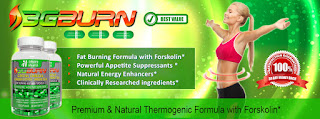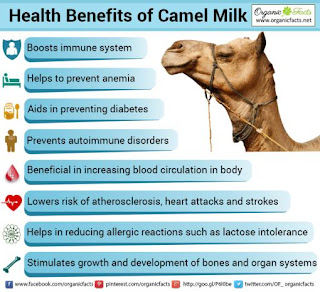Camel's milk has supported Bedouin, nomad and pastoral cultures since the domestication of camels millennia ago. Herders may for periods survive solely on the milk when taking the camels on long distances to graze in desert and arid environments.
Camel dairy farming is an alternative to cow dairy farming in dry regions of the world where bovine farming consumes large amounts of water and electricity to power air-conditioned halls and cooling sprinkler systems. Camel farming, by utilising a native species well-adapted to arid regions, able to eat salty desert plants, has been linked to de-desertification by UNESCO. Camel milk can be found in supermarkets in the UAE, Somalia, Saudi Arabia, Mauritania, and the United States.
Camel milk is a rich source of proteins with potential antimicrobial and protective activities; these proteins are not found in cow milk or found only in minor amount.[citation needed] Camel milk has enough nutrients to sustain a person through the day. In many countries, camel milk is given to babies suffering from malnutrition.
Compared to cow, buffalo and ewe milk fat, camel milk fat contains fewer short-chained fatty acids, but the same long-chained fatty acids can be found. Some researchers[who?] claim that the value of camel milk is to be found in the high concentrations of linoleic acid among other polyunsaturated fatty acids, which are essential for human nutrition.[clarification needed] Camel milk has more fat and protein than cow's milk.[1] Cholesterol in camel milk is lower than cow or goat milk.
Camel milk has a high vitamin and mineral content and immunoglobin content.[2] Camel milk is three times higher in vitamin C than cow's milk and 10 times higher in iron. It is also high in unsaturated fatty acids and B vitamins but lower in vitamin A and B2 (than cow milk). The composition of camel milk depends on its feed and species: Bactrian milk has a higher fat content than dromedary milk.
Camel milk is lower in lactose than cow's milk.[3] However, levels of potassium,[3] magnesium, iron,[3] copper, manganese, sodium and zinc are higher than in cow's milk.
Camel milk is still largely a subsistence product, but production in camel milk dairies is a growing industry.
India
Camel milk in India has been used by raika and other desert communities, it also finds its presence in the ancient Indian medicinal texts of Ayurveda. The National Research Centre on Camel in Bikaner, Rajasthan, India is a national camel research institute which has participated in research projects on the therapeutic values of camel milk in autism, diabetes, TB, hepatitis, etc.
USA
The USA has an imported population of 5,000 camels.
Laws in the United States allow an individual who owns an animal to consume that animal's milk but until recently it was a felony to sell camel milk in the US. Milk sold in the U.S. must be tested for antibiotic residue if it crosses state lines or is sold commercially in stores. As the law stands in most states, the dairies are allowed to sell the milk directly from the farms to customers who buy it directly from the farm. Each state is different with regulations governing the sale of the milk. Milk is allowed to be sold, depending on the state, in raw form, pasteurized, or cow share program.
The current market for the milk in the US is for medical purposes and as a food for ethnic populations. There is also a very large demand for the colostrum, which is in very limited amounts and is quite expensive.
The cost of producing a quart of camel's milk is considerably higher than that of producing a quart of cow's milk; approximately fifty times more expensive. In the United States, female camels are very rare; they mature slowly and can be bred safely only after age four. Their thirteen-month gestation period must conclude in a live birth followed by suckling, else the female camel will stop producing milk. Unlike a dairy cow which is parted from her calf when it is born and then gives milk for six to nine months, a camel can share her milk with the farmer and her calf for twelve to eighteen months. [5]
Milk yields
Pakistani and Afghani camels are supposed to produce the highest yields of milk, up to 30 litres per day. The Bactrian camel produces 5 litres per day and the dromedary produces an average of 20 litres per day.[1] Intensive breeding of cows has created animals that can produce 40 litres per day in ideal conditions. Camels, with their ability to go 21 days without drinking water, and produce milk even when feeding on low-quality fodder, are a sustainable option for food security in difficult environments.
Camel cheese
Cheese from camel milk is more difficult to make than cheese from the milk of other dairy animals.[6] It does not coagulate easily and bovine rennet fails to coagulate the milk effectively. In camel herding communities camel milk cheeses use spontaneous fermentation, or lactic fermentation to achieve a sour curd. In camel farms in Sudan, the Rashaida tribe use this method to store surplus milk in the rainy season, pulverising the dried curds and adding water for consumption in the dry season. In Mongolia camel milk is consumed as a product at various stages of the curd-making process. Recent advances in cheese making technology have made it possible to coagulate camel milk with a vegetable rennet and camel rennet.
Mauritania
A European-style cheese was created through collaboration between Mauritanian camel milk dairy Tiviski, the FAO, and professor J.P. Ramet of the École Nationale Supérieure d'Agronomie et des Industries Alimentaires (ENSAIA). Curdling was produced by the addition of calcium phosphate and vegetable rennet. Caravane, the subsequently produced cheese is a product of Tiviski, and sold in supermarkets in Nouakchott. EU restrictions prevent this product from being sold in the EU. Difficulties with the cold chain and economy of scale prevent the camel cheese from being sold in the US.
Camel milk as a medicine
Camel milk is believed to modulate the immune system. A study of eight children showed its ability to ameliorate allergies in children.[7]
Camel milk is also used as a medicinal product in India. The Bedouins of the Middle East believe it to have curative powers.[1] Camel milk has also been used in cosmetic products because of the benefits of reducing acne bacteria in the skin.



